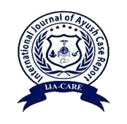Conservative Ayurvedic Medical Management in an Elderly Person with Fourth Degree Haemorrhoids- A Case Report
Abstract
Haemorrhoids are a widespread lifestyle disorder with a high incidence rate. The superior, middle, and inferior rectal veins generate the radicles of haemorrhoids, which are dilated veins within the anal canal in the subepithelial region. The most severe form of haemorrhoids, in which the piles have fully prolapsed, are known as fourth degree haemorrhoids. In this case report, a 70-year-old male patient visited to outpatient department of GAVC Tripunithura with complaints of mass per rectum associated with severe pain for four days. On local examination, the case was diagnosed as fourth degree inflamed haemorrhoids at 3, 7, 11 o clock position. The case was managed with internal medication, sitz bath in triphala kashaya and murivenna local application. The mass was reduced partially within 15 days and completely reduced in 1 month. No complications were reported after the treatment. Hence this case highlighted a case of inflamed fourth degree haemorrhoids managed with conservative ayurvedic treatment protocol using nirgata arsha chikitsa and udavarta chikitsa within a short period of time.

This work is licensed under a Creative Commons Attribution-NonCommercial-NoDerivatives 4.0 International License.

